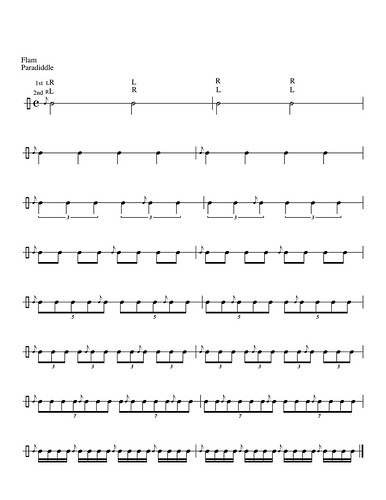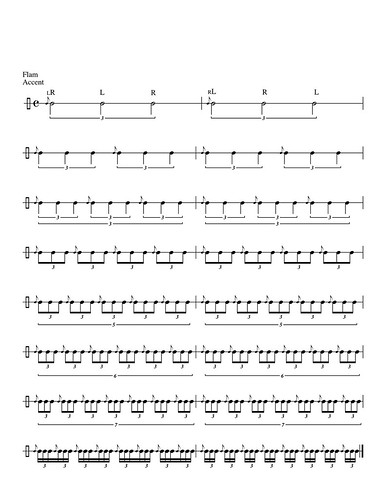 CLICK ON THE EXERCISE TO DOWNLOAD
CLICK ON THE EXERCISE TO DOWNLOADI've mentioned this before, but in the past I wasn't thrilled about practicing rudiments...sorry, understated that, I used to HATE practicing them. The problem was,
my college professor was huge on them...he actually wrote the book on it (
The Drummer's Rudimental Reference Book…click on it to check it out, it's the best on the subject in my opinion). Me hating rudiments was akin to shooting his firstborn. There was no way around it...to get out of college I was going to have to learn them...so while I was at it I decided I would try to also learn to LIKE them, a different task altogether.
They really are a vital part of a drummer's “arsenal”. Everyday folks have the alphabet, horn players have scales, the library has the Dewey Decimal System (which NEVER made sense to me when I was a kid)...and we have rudiments.
Can you talk without knowing the alphabet?
Absolutely.
Can you talk well without knowing the alphabet?
Sure.
The alphabet does nothing but organize a language. Once you understand what letters look and sound like, why they have those sounds, how you can rearrange them and make different combinations of sounds...that's when you really begin to become proficient in a language.
Rudiments are the alphabet for drummers, it's as simple as that.
Can you play without knowing your rudiments?
Sure.
Can you play WELL without knowing your rudiments?
Absolutely.
…but if there was a better way to organize your thoughts while you were playing, it only makes sense to learn it…enter rudiments...
So I had to find a way to like them...a way to practice them that didn't make me want to drive stakes through my eyes.
I've mentioned
some of the other ways I tried and liked...Practicing rudiments to your favorite songs, moving them around the drumkit, etc.
When I started messing with the
Rhythmic Scale, I found another way to get enjoyment out of them. I'm a big believer in trying to multitask while practicing...in other words, if you're going to be working on your funk grooves, why not try to incorporate working on dynamics, technique, timing, etc all at one time. Some of you may say, “I already do that.”...and maybe you do, but what I like to do is actually focus on those issues one at a time while I'm practicing another concept. Get whatever concept that you're working on under your hands and then put that part of it on autopilot and start to focus in on other issues…so you're practicing your new concept while also honing some of the most basic aspects of your playing, aspects that sometimes get overlooked in the quest for the fastest hands…or feet…or whatever...
The typical way to go through a rudiment is as follows...
1. Learn rudiment.
2. Play rudiment from slow to fast and back to slow.
3. Repeat.
I understand the thinking...it helps you to explore playing that rudiment at all different tempos while also helping you push your speed to new levels. This gets boring to me quickly. Once I learn the rudiment, the thought of playing it from slow to fast and back down just to help me get quicker hands wasn't enough of a goal in and of itself to keep my interest.
The solution I came up with was simple but effective. I took whatever rudiment I was working on at the time (the example written out here is the Flam) and applied the
Rhythmic Scale to it. I would set my metronome at a tempo that allowed me to play the whole
Scale...once I was comfortable playing all of those subdivisions at that tempo, I would increase the tempo. Doing this allowed me to work with a metronome while working on my rudiments, therefore helping my timing and groove.
So the new way to go through the rudiment would be much more in depth…
1. Learn rudiment.
2. Decide on comfortable metronome speed and play rudiment while applying steps 1-8 of the
Rhythmic Scale.3. Focus on counting each subdivision within the scale until you're comfortable with how it lays under your hands.
4. Start to hone in on dynamics…soft to loud, loud to soft, soft to loud and back down to soft, one measure loud and the next soft, etc...
5. Increase tempo as able.
After I'm comfortable playing the rudiments in all subdivisions of the
scale, I turn on the music. Pick your fav song, pick a degree of the
scale you want to work on, and play that degree through the whole song...now we're starting to get REALLY comfortable with them...and we're forgetting that we're working on rudiments.
Once you're comfortable with all of these, start moving them around the drumkit...the possibilities are endless. Put your left hand on the snare and your right hand on the floor tom…or any other combination you can think of…go wild with it!
…And before you know it, you've taken a very boring idea and turned it into a series of exercises and combinations that begin to sound musical…which is the end goal of any practice session.
I've written out the flam rudiment as it looks going through the
Rhythmic Scale. It's one of the easier to count and subdivide at first. I'll be putting a lot more of them up in the near future as I'm able…life is really busy right now, really good stuff, just really busy though (If you'll continue to watch this space I'll let you in on all of it as I'm able to…). If you see some highlighted words in any of the lesson posts you can click on them and they'll refer you back to whatever post it is that explains the words or topic that is highlighted, just so you'll be able to reference things easier…or if you're just jumping in you'll be able to get caught up quickly. Don't hesitate to shoot me a line through
FB,
Twitter, email, or in the comments section of this post if you've got any questions or comments…I love hearing from you guys!
Now go to the woodshed and hack out some rudiments...











